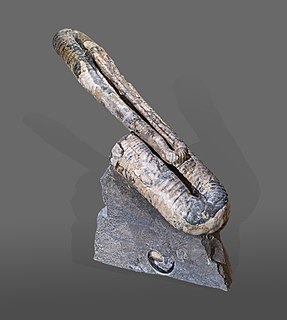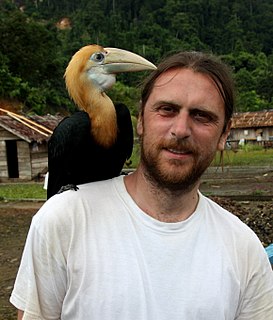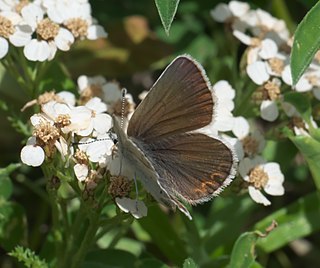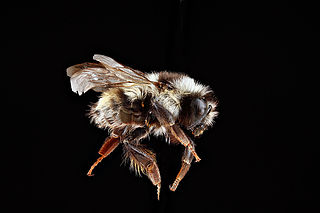
Convolvulaceae, known commonly as the bindweed or morning glory family, is a family of about 60 genera and more than 1,650 species of mostly herbaceous vines, but also trees, shrubs and herbs, and also including the sweet potato and a few other food tubers.

The Vancouver Island marmot naturally occurs only in the high mountains of Vancouver Island, in the British Columbia. This particular marmot species is large compared to some other marmots, and most other rodents. Marmots as a group are the largest members of the squirrel family, with weights of adults varying from 3 to 7 kg depending on age and time of year.
Limatula, the file shells or file clams, is a genus of marine bivalve molluscs in the family Limidae.

Polyptychoceras is an extinct genus of ammonites from the Late Cretaceous of Asia, Europe, and North and South America. It was first named by Hisakatsu Yabe in 1927.

Agrotis vancouverensis, the Vancouver dart, is a moth of the family Noctuidae. The species was first described by Augustus Radcliffe Grote in 1873. It is found in the Pacific Northwest of North America and is common west of the Cascade Mountains.

Erannis tiliaria, the linden looper, also known under the rather ambiguous name "winter moth", is a moth of the family Geometridae. The species was first described by Thaddeus William Harris in 1841. It is found in North America from central Alberta east to Nova Scotia, south to Missouri, Georgia, Utah and Texas.
Turbonilla vancouverensis is a species of sea snail, a marine gastropod mollusk in the family Pyramidellidae, the pyrams and their allies.
Diandrya is a genus of cestode parasites that are known from marmots in North America. The species Diandrya composita, described along with the genus by J. G. Darrah in 1930, is known from all North American marmots except the woodchuck. The species D. vancouverensis, described by T. F. Mace and C. D. Shepard in 1981, is only known from the Vancouver marmot, an island endemic on Vancouver Island.
Bombus bifarius, the two-form bumblebee, is a species of eusocial bumblebee of the subgenus Pyrobombus. B. bifarius inhabits mountainous regions of western North America, primarily the states of Colorado and Utah. Its common name refers to a historical artifact, in that it was believed that this species had a color polymorphism, with a red-tailed nominate form and a black-tailed nearcticus form, present in the species. This polymorphism has recently been shown to belong instead to a cryptic sister species, Bombus vancouverensis, that occupies almost the entirety of the range of what was formerly classified as bifarius; true bifarius only has a red form, so it is not "two-formed" at all.

Dmitry Telnov is a Latvian entomologist, biogeographer, and conservationist. He is a member and vice president of the Entomological Society of Latvia as well as the chief editor of the "Biodiversity, biogeography and nature conservation in Wallacea and New Guinea" book series, as well as a member of the Editorial Board of the "Latvijas Entomologs" journal. He is primarily known for his taxonomic works on Coleoptera and biogeographic research in the Papuan region and in the Wallacea.
Ischalia costata is a species of broad-hipped flower beetle in the family Ischaliidae. It is found in North America.
Ischalia is a genus of broad-hipped flower beetles in the family Ischaliidae, and the only genus of the subfamily Ischaliinae. There are at least 3 described species in Ischalia.

Erannis vancouverensis is a species of geometrid moth in the family Geometridae.
Carpelimus vancouverensis is a species of spiny-legged rove beetle in the family Staphylinidae. It is found in North America.
Ischalia californica is a species of broad-hipped flower beetle in the family Scraptiidae. It is found in North America.
Ilybius vancouverensis is a species of predaceous diving beetle in the family Dytiscidae. It is found in North America.

Plebejus anna, or Anna's blue, is a species of blue in the butterfly family Lycaenidae. It is found in North America.
Solariella vancouverensis is a species of sea snail, a marine gastropod mollusk, in the family Solariellidae.
Animal Ethics is a nonprofit organization formed to promote discussion and debate around issues in animal ethics and to provide information and resources for animal advocates. They also do outreach work in several countries on the issue of speciesism. Their aim is to create a world where moral consideration is extended to all sentient beings. The organization's website covers topics such as speciesism, sentience, veganism and wild animal suffering and has content translated into several languages.

Bombus vancouverensis is a common species of eusocial bumblebee of the subgenus Pyrobombus. B. vancouverensis inhabits mountainous regions of western North America, where it has long been considered as a synonym of Bombus bifarius, and essentially all of the literature on bifarius refers instead to vancouverensis. B. vancouverensis has been identified as one of the two species of bumblebee observed to use pheromones in kin recognition. The other is the frigid bumblebee, Bombus frigidus.








